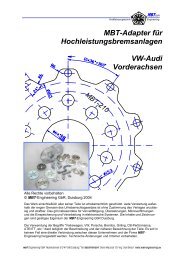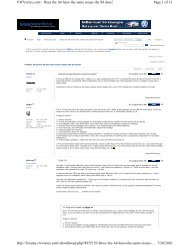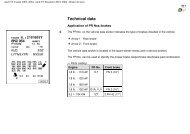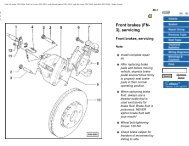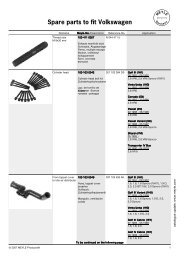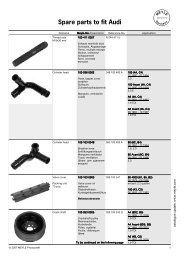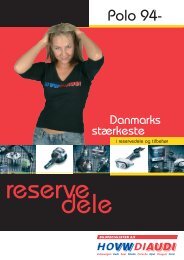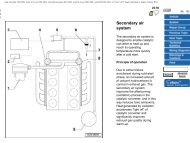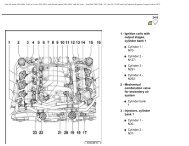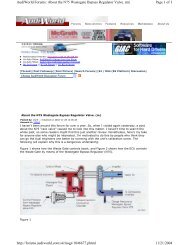VW MKII A2 MK2 Golf Jetta Fox Service Manual - VAGLinks.com
VW MKII A2 MK2 Golf Jetta Fox Service Manual - VAGLinks.com
VW MKII A2 MK2 Golf Jetta Fox Service Manual - VAGLinks.com
Create successful ePaper yourself
Turn your PDF publications into a flip-book with our unique Google optimized e-Paper software.
Fuel supply<br />
The fuel pump operates continuously while<br />
the engine is running, excess fuel being<br />
returned to the fuel tank. The pump is<br />
operated when the ignition switch is in the<br />
START position. Once the starter is released,<br />
a switch which is connected to the air plate,<br />
prevents the pump from operating unless the<br />
engine is running.<br />
The fuel line to the fuel supply valve<br />
incorporates a filter and also a fuel<br />
accumulator. The function of the accumulator<br />
is to maintain pressure in the fuel system after<br />
the engine has been switched off and so give<br />
good hot restarting.<br />
Associated with the accumulator is a<br />
pressure regulator which is an integral part of<br />
the fuel metering device. When the engine is<br />
switched off, the pressure regulator lets the<br />
pressure to the injection valves fall rapidly to<br />
cut off the fuel flow through them and so<br />
prevent the engine from “dieseling” or<br />
“running on”. The valve closes at just below<br />
the opening pressure of the injector valves<br />
and this pressure is then maintained by the<br />
accumulator.<br />
Fuel distributor<br />
The fuel distributor is mounted on the air<br />
metering device and is controlled by the<br />
vertical movement of the airflow sensor plate.<br />
It <strong>com</strong>prises a spool valve which moves<br />
vertically in a sleeve, the sleeve having as<br />
many vertical slots around its circumference<br />
as there are cylinders on the engine.<br />
The spool valve is adjusted to hydraulic<br />
pressure on the upper end and this balances<br />
the pressure on the air plate which is applied<br />
to the bottom of the valve by a plunger. As the<br />
spool valve rises and falls, it uncovers a<br />
greater or lesser length of metering slot and<br />
so controls the volume of fuel fed to each<br />
injector.<br />
Each metering slot has a differential<br />
pressure valve, which ensures that the<br />
difference in pressure between the two sides<br />
of the slot is always the same. Because the<br />
drop in pressure across the metering slot is<br />
unaffected by the length of slot exposed, the<br />
amount of fuel flowing depends only on the<br />
exposed area of the slots.<br />
Cold start valve<br />
The cold start valve is mounted in the inlet<br />
manifold and sprays additional fuel into the<br />
manifold during cold starting. The valve is<br />
solenoid operated and is controlled by a<br />
thermotime switch in the engine cooling<br />
system. The thermotime switch is actuated for<br />
a period which depends upon coolant<br />
temperature, the period decreasing with rise<br />
in coolant temperature. If the coolant<br />
temperature is high enough for the engine not<br />
to need additional fuel for starting, the switch<br />
does not operate.<br />
Warm-up regulator (valve)<br />
While warming up, the engine needs a<br />
richer mixture to <strong>com</strong>pensate for fuel which<br />
Fuel and exhaust systems - K-Jetronic fuel injection - 8 valve engines 4B•3<br />
condenses on the cold walls of the inlet<br />
manifold and cylinder walls. It also needs<br />
more fuel to <strong>com</strong>pensate for power lost<br />
because of increased friction losses and<br />
increased oil drag in a cold engine. The<br />
mixture is made richer during warming up by<br />
the warm-up regulator. This is a pressure<br />
regulator which lowers the pressure applied to<br />
the control plunger of the fuel regulator during<br />
warm-up. This reduced pressure causes the<br />
airflow plate to rise higher than it would do<br />
otherwise, thus uncovering a greater length of<br />
metering slot and making the mixture richer.<br />
The valve is operated by a bi-metallic strip<br />
which is heated by an electric heater. When<br />
the engine is cold, the bi-metallic strip<br />
presses against the delivery valve spring to<br />
reduce the pressure on the diaphragm and<br />
enlarge the discharge cross-section. This<br />
increase in cross-section results in a lowering<br />
of the pressure fed to the control plunger.<br />
Auxiliary air device<br />
Compensation for power lost by greater<br />
friction is achieved by feeding a larger volume<br />
of fuel/air mixture to the engine than is<br />
supplied by the normal opening of the throttle.<br />
The auxiliary air device bypasses the throttle<br />
with a channel having a variable aperture<br />
valve in it. The aperture is varied by a pivoted<br />
plate controlled by a spring and a bi-metallic<br />
strip.<br />
During cold starting, the channel is open<br />
and increases the volume of air passing to the<br />
engine. As the bi-metallic strip bends, it<br />
allows a control spring to pull the plate over<br />
the aperture until at normal operating<br />
temperature the aperture is closed.<br />
Cold acceleration enrichment<br />
This system is fitted to later models only.<br />
When the engine is cold (below 35°C),<br />
acceleration is improved by briefly enriching<br />
the fuel mixture for a period of approximately<br />
0.4 seconds. This cold acceleration<br />
enrichment will only operate if the thermotime<br />
switch, the diaphragm pressure switch and<br />
the throttle valve switch are shut off.<br />
Temperature sensor<br />
From March 1986, a temperature sensor is<br />
located between injectors 1 and 2. After<br />
switching off the ignition, this switches on the<br />
cooling fan when the temperature of the<br />
cylinder head exceeds 110°C. A time relay is<br />
incorporated in the circuit. This switches off<br />
the function between ten and twelve minutes<br />
after switching off the ignition.<br />
Precautions<br />
Fuel warning<br />
Many of the procedures in this Chapter<br />
require the removal of fuel lines and<br />
connections which may result in some fuel<br />
spillage. Before carrying out any operation on<br />
the fuel system, refer to the precautions given<br />
in Safety first! at the beginning of this <strong>Manual</strong><br />
and follow them implicitly. Petrol is a highly<br />
1081 <strong>VW</strong> <strong>Golf</strong> & <strong>Jetta</strong><br />
dangerous and volatile liquid and the<br />
precautions necessary when handling it<br />
cannot be overstressed.<br />
Fuel injection system warning<br />
Residual pressure will remain in the fuel<br />
lines long after the vehicle was last used,<br />
therefore extra care must be taken when<br />
disconnecting a fuel line.<br />
Loosen any fuel line slowly to avoid a<br />
sudden release of pressure which may cause<br />
fuel spray. As an added precaution, place a<br />
rag over each union as it is disconnected to<br />
catch any fuel which is forcibly expelled.<br />
Take particular care to ensure that no dirt is<br />
allowed to enter the system. The ignition must<br />
be off and the battery disconnected.<br />
Unleaded petrol - usage<br />
Refer to Part A of this Chapter.<br />
Catalytic converters<br />
Before attempting work on these items,<br />
carefully read the precautions listed in the<br />
following Section.<br />
2 Catalytic converters - general<br />
information and precautions<br />
The catalytic converter is a reliable and<br />
simple device which needs no maintenance in<br />
itself, but there are some facts of which an<br />
owner should be aware if the converter is to<br />
function properly for its full service life.<br />
a) DO NOT use leaded petrol in a vehicle<br />
equipped with a catalytic converter - the<br />
lead will coat the precious metals,<br />
reducing their converting efficiency and<br />
will eventually destroy the converter.<br />
b) Always keep the ignition and fuel systems<br />
well-maintained in accordance with the<br />
manufacturer’s schedule. Ensure that the<br />
air cleaner element, fuel filter and spark<br />
plugs are renewed at the correct intervals.<br />
If the inlet air/fuel mixture is allowed to<br />
be<strong>com</strong>e too rich due to neglect, the<br />
unburned surplus will enter and burn in<br />
the catalytic converter, overheating the<br />
element and eventually destroying the<br />
converter.<br />
c) If the engine develops a misfire, do not<br />
drive the vehicle at all (or at least as little<br />
as possible) until the fault is cured. The<br />
misfire will allow unburned fuel to enter<br />
the converter, which will result in its<br />
overheating.<br />
d) DO NOT push or tow-start the vehicle.<br />
This will soak the catalytic converter in<br />
unburned fuel, causing it to overheat<br />
when the engine does start.<br />
e) DO NOT switch off the ignition at high<br />
engine speeds. If the ignition is switched<br />
off at anything above idle speed,<br />
unburned fuel will enter the (very hot)<br />
catalytic converter, with the possible risk<br />
of its igniting on the element and<br />
damaging the converter.<br />
4B



